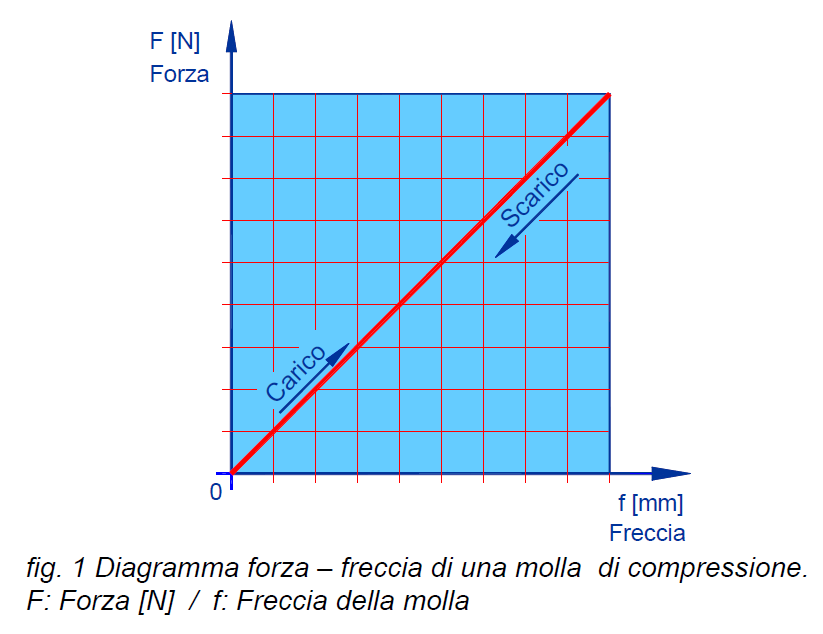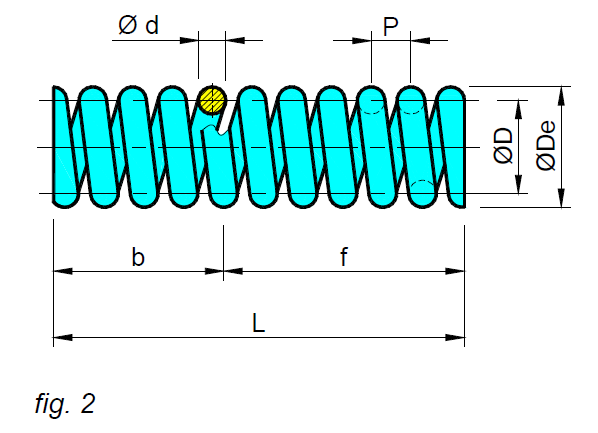Many are the products showed in this catalogue, see table at page 06, and a remarkable part concerns the axial and rotational elastic elements, that are mainly used as automatic chain tensioners and belt tensioners.
The axial elastic elements of TECNIDEA CIDUE are box-shaped bodies that use as propulsor one or more cylindric compression springs, so they act in this manner and they respect all the rules that regulate the cylindrical spiral springs. Herewith are illustarted the main features for their use and in each section of the catalogue are indicated the values of load and of arrow for each single elastic element. In all these articles the functioning is granted by one or more cylindrical springs with circular sections that work through compression (drawing 1-2-3-4) or through combined compressive and bending stress (drawing 5). In mechanics this is one of the products with an extensive use both for the functional semplicity and for the very long and the tested utilization.
Springs are mechanical units that, through external forces, suffer many deformations with accumulation of energy; when the stresses cease, this energy is in a large part released. This peculiarity allows to use them in various ways, which are mainly:
a) to eliminate or to reduce the effects of impacts, shakes and vibrations etc, so they work as shock absorbers and decelerator unit;
b) to grant the contact between two or more parts of a mechanism, so they work as down holders;
c) to increase, also in a relevant way, the movements of mechanical units, so they work as accelerator.
In 1676 the english physicist Rober Hooke discovered a functional relation suitable to schematize the action of the spring, or rather that the force exerted is proportional to its extention: "Ut tensio, sic vis" that is “as the extention, so is the force”. This relation is called the Law of Hooke, or rather F=R.f (see figure1)
F: Force [N]
R: costant of stiffness of the spring [N/m]
f: Compression arrow from the free length of the spring
The law of Hooke is valid within the limit of elastic deformation, defined as the limit of maximum applied force within which the elastic released body returns to its dimensions previous to the application of the force; over this limit the linkages break themselves, and the spring deforms itself permanently. In many materials this limit is not defined with precision and there are phenomena of deformation with the repeated utilization (ageing): in these cases the law of Hooke is not respected.
Are considered subjected to static condition of tension, the springs working with a constant load and subjected to an occasional change of load that is so deferred over the time to totalize less than 10.000 alternances during all the life of the spring. For springs subjected to static condition of tension, the settling or the braking can happen exclusively consequently to the reaching of the elastic limit of the spring.
Are considered subjected to dynamic condition of tension:
- the springs working with periodical variable load between two fixed values
- subjected to variable load in an occasional way periodically between two fixed values
- subjected to variable load in an occasional way with such a frequenz to totalize almost 10000 alternances during all the life of the spring.
The breaking of the working springs in the dynamic condition of tension, happens for fatigue after a number of alternances depending, besides to the maximum tension of exercise, also on the extension of the tension range in which works the spring. For the springs, on the base of the experiences made, are considered three types of service: light, medium and heavy.
LIGHT SERVICE:
Springs subjected to only static load or with small deflections together with low stesses.
MEDIUN SERVICE:
It includes the majority of screws for general use for example in the motors, brakes, commutators, mechanical machines and products. Deflections of normal frequencies and medium use of the loads.
HEAVY SERVICE:
Springs subjected to quick deflections, for long periods of time, for example valves for motors of cars and planes, pneumatic hammers, hydraulic brakes.
The correct dimensioning, therefore a reduction of up to 35% of the values at static condition, can allow a safe use up to one million deflections.
It is difficult to determine the minimum and maximum limits of the temperature for the materials used for the springs. In fact the resistance values can change considerably from a spring to another one. Anyway, there is a temperature, or a strict range of temperatures, above or below which the properties are subjected to a quick worsening. Anyhow it must be reminded that the elasticity module varies with the change of the temperature. So the spring can resist according to the material they are made by and this is:
Steel C: From -30°C to +120°C
Stainless steel: From -200°C to +250°C
For high temperature working conditions it is necessary to use special metarials as Cr-Si alloy steels until about 250°C, or special alloys as Inconel for temperature higher than 500°C. For dynamic stresses, the fatigue strenght of a spring depends on many factors as temperature, environment (corrosive/not corrosive), width of stresses.
Ød= thread diameter of the spring [mm]
ØD= medium diameter of the spring [mm]
F= maximum force
b= length block, that is the length of the spring when is all compressed [mm]
f= arrow of the spring with maximum force F
P= pitch, medium distance between two successive turns of a spring
L= free length, the free length is estimated in the not compressed state of the spring L=b+f
n= total number of turns. To calculate the number of active turns, you just have to deduct the two turns of the ends
R= stiffness costant [N/m]
The force F1 when the spring is compressed to a length L1 can be estimated with the following equation: F1 = R * (L-L1)
Are considered steel for spring all the details in drawn steel or rolled steel subjected to elastic stesses of various type, as compression, torsion, traction, etc…, that can be in its turn, static or to fatigue. So the main feature that the steels for spings must have, is to grant an high elasticity, that in its turn is given by the massive presence of silicon (from 0.15% to 2.0%) in its chemical formulation. It is better to divide the types of steels in two different categories: Not alloyed steels :C60, C72, C85, C98, (stenght from 1100 to 2900 N/mm2) for uses to room-temperature. Alloy steels: CrSi, CrV, for utilizations at high temperature or subjected to stess. These steels are also called carbon steels because of the strong presence of carbon that varies from 0.50% to 0.98%.
Generally these steels are cold worked and then they are subjected to a heat treatment in order to eliminate all the stresses and the tensions that are accumulated during the working; following this passage, the mechanical features of the steel remain unchanged and constant during the time, granting lasting reactions in the acceptable limits for the materials and the working conditions required. The main reference rules are UNI 3823 EN 10270-1/2 DIN 17223.
The steels for springs have, as characteristic property, the possession of a high limit of elasticity that can be obteined in two manners:
- with strain hardening for plastic deformation by drawing or rolling, made on carbon steels or weakly alloyed;
- with heat treatment of temper gardening at 400-450° made on steels with medium proportion of carbon, alloyed to Silicon or to Chromium and Vanadium.
Both the solutions allow to obtain very high yield points. The unification tables for these steels are UNI 7064 and UNI 3545.
Own frequency “fn“ The own or natural frequency in a simple system mass-spring is given by:
in which M is the mass of the weight attached to the spring.
TECNIDEA CIDUE in its products uses different materials and surface treatments for the realization of its articles.
Steel: in the pieces made by turning are generally used steels added to the lead as 11SMnPb37 (AVP). The pieces made by laser cut, milling or bending or welding are realized in Fe 360. The bolts and nuts used are in the classification 8.8. In production line “BLU” is used the AISI 304 stainless steel.
Brass: the sliding pieces are realized in Brass Ot 58 by turning
Alluminium alloy: in the pieces made by die-casting is used the alloy 46100, in the pieces realized by chill casting is used the alloy EN AB 44100, while in the section bars obtained by extrusion is used the alloy T6060.
Polyethylene: in the pieces made for the sliding of the chains (sliding blocks and wheelsets) is used the polyethylene PE 1000, generally green colored, with molecular weight 1.000.000.
Polyamide: in the rollers for belts is used the polyamide PA 6 + So.Mo.
The surface treatments are:
Sandblasting: the pieces in aluminium or stainless steel (link plates or forks in production “BLU” line) are sandblasted to increase the aesthetical effect and the features of anticorrosion.
Electrolytic galvanizing: the galvanized pieces are realized by electrolytic galvanizing al least Fe/Zn 5c1A.
Oven-baked painting: the painted pieces are made by painting annealed in the oven to 200°C or with spray painting.
On demand we can realize articles or components with surface treatments different from the standard ones, as the nickel-plating or hot dip galvanizing.






